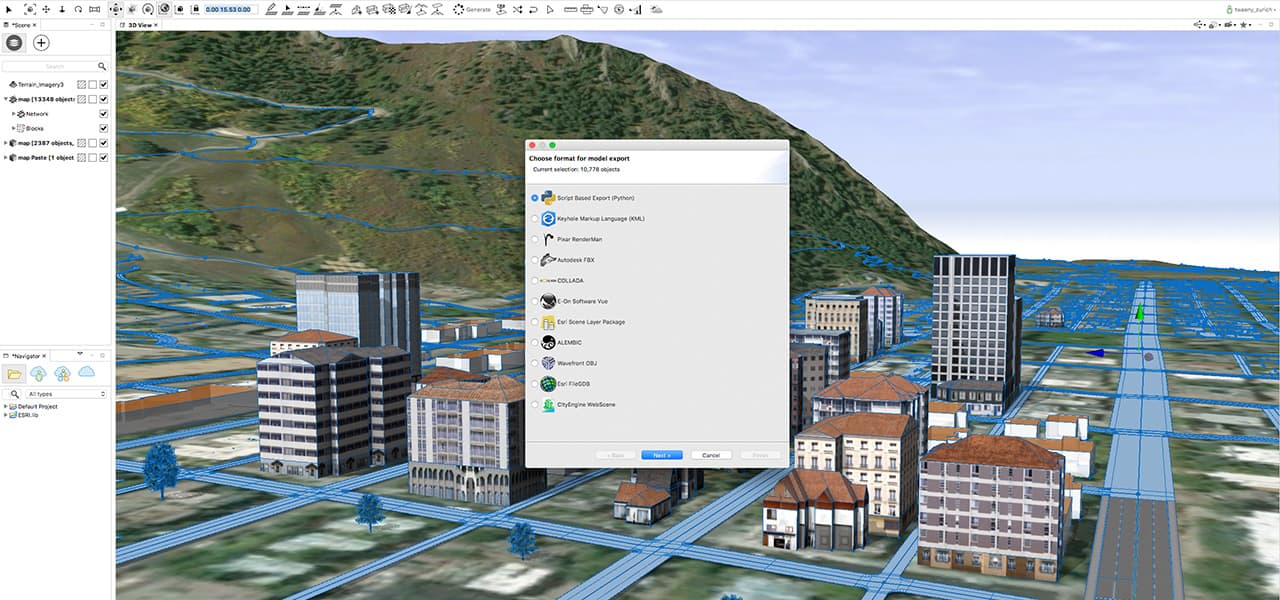
Kindle a massive city all at once more of modelling each pressure individually. At this point the city model can be re-designed and adjusted by changing parameters or the shape grammar itself.Esri CityEngine. Due to the underlying procedural modeling technology all buildings can be made to vary from one another to achieve a urban aesthetic. Now by selecting all or some of the lots CityEngine can be instructed to start generating the buildings. Next step is to subdivide all the lots as many times as specified resulting in a urban map of lots and streets (see the New York 2259 example). Modeling an urban environment within CityEngine usually starts out with creating a street network either with the street drawing tool or via maps imported from. A user can change or add the shape grammar as much as needed providing room for new design possibilities. The rules are defined through a CGA shape grammar system enabling the creation of complex parametric models.
#Esri cityengine 2012 mac osx#
Included are demo cities of ancient, contemporary and future cities.Īvailable for All Platforms: Available for Windows (32/64bit), Mac OSX (64bit), and Linux (32/64bit).ĬityEngine uses a procedural modeling approach which means it automatically generates models through a predefined rule set. Training Materials & Provided Examples: Several learning videos and tutorials demonstrate you the basics and key concepts of CityEngine. Python: Streamline repetitive or pipeline-specific tasks with the integrated Python scripting interface.

automatically calculate quantities such as GFA, FAR, etc. Reporting (BIM for Cities): Customized rule-based reports can be generated to analyze the urban design e.g. Industry-Standard 3D Formats: CityEngine supports Collada, Autodesk® FBX®, 3DS, Wavefront OBJ, RenderMan® RIB, mental ray® MI and e-on software's Vue, which allow for flawless 3D data exchange. Map-Controlled City Modeling: Any parameter of the buildings and streets can be controlled globally via image maps (for example the building heights or the landuse-mix). Parametric Modeling Interface: A convenient interface to interactively control specific street or building parameters such as the height or age (defined by the CGA rules) Rule-based Modeling Core: Procedural modeling based on CGA rules allows to control mass, geometry assets, proportions, or texturing of buildings or streets on a city-wide scale.įacade Wizard: Quickly create rules out of an image or a textured mass model with this simple and easy-to-use visual facade authoring tool. Street Networks Patterns: Unique street grow tools to quickly design and construct urban layouts. OpenStreetMap Import: Use data from OpenStreetMap to copy real cities.ĭynamic City Layouts: Interactively design, edit and modify urban layouts consisting of (curved) streets, blocks and parcels.

GIS/CAD Data Support: Support for industry-standard formats (ESRI Shapefile or DXF) which allow to import/export any geo-spatial/vector data. The key highlights of CityEngine include:

#Esri cityengine 2012 software#
The founders and employees of Procedural will be employed by Esri, and Procedural's offices in Zurich will be extended to a leading-edge R&D center in the field of urban design and 3D content creation.ĬityEngine is a standalone software that provides professional users in entertainment, architecture, urban planning, GIS and general 3D content production with a unique conceptual design and modeling solution for the efficient creation of 3D cities and buildings. Esri will integrate CityEngine technologies into ArcGIS, and CityEngine will continue to evolve and expand as a stand-alone product. In 2008, the first commercial version of CityEngine was released by Swiss company Procedural Inc and is used by professionals in urban planning, architecture, visualization, game development, entertainment, GIS, archeology and cultural heritage]]. Several more research papers have featured CityEngine since then. In the 2001 Siggraph publication ( Procedural Modeling of Cities - Yoav Parish and Pascal Mueller) CityEngine is presented for the first time outside of the research community. During his PhD research at ETH Computer Vision Lab, Mueller invented a number of ground breaking techniques for the procedural modeling of 3D architectural content which make up the foundation of CityEngine today. CityEngine was developed at ETH Zurich by the original author Pascal Mueller, co-founder and CEO of


 0 kommentar(er)
0 kommentar(er)
